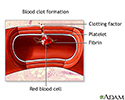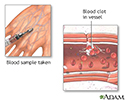Disseminated intravascular coagulation (DIC)
Consumption coagulopathy; DICDisseminated intravascular coagulation (DIC) is a serious disorder in which the proteins that control blood clotting become overactive.
Causes
When you are injured, proteins in the blood that form blood clots travel to the injury site to help stop bleeding. If these proteins become abnormally active throughout the body, you could develop DIC. The underlying cause is usually due to inflammation, infection, or cancer.
In some cases of DIC, small blood clots form in the blood vessels. Some of these clots can clog the vessels and cut off the normal blood supply to organs such as the liver, brain, or kidneys. Lack of blood flow can damage and cause major injury to the organs.
Blood clots
Blood clots are clumps that occur when blood hardens from a liquid to a solid. A blood clot that forms inside one of your veins or arteries is calle...

In other cases of DIC, the clotting proteins in your blood are consumed. When this happens, you may have a high risk of serious bleeding, even from a minor injury or without injury. You may also have bleeding that starts spontaneously (on its own). The disease can also cause your healthy red blood cells to fragment and break up when they travel through the small vessels that are filled with clots.
Risk factors for DIC include:
- Blood transfusion reaction
Blood transfusion reaction
A hemolytic transfusion reaction is a serious complication that can occur after a blood transfusion. The reaction occurs when the red blood cells th...
 ImageRead Article Now Book Mark Article
ImageRead Article Now Book Mark Article - Cancer, especially certain types of leukemia
Leukemia
Leukemia is a type of blood cancer that begins in the bone marrow. Bone marrow is the soft tissue in the center of the bones, where blood cells are ...
 ImageRead Article Now Book Mark Article
ImageRead Article Now Book Mark Article - Inflammation of the pancreas (pancreatitis)
- Infection in the blood, especially by bacteria or fungus
- Liver disease
Liver disease
The term "liver disease" applies to many conditions that stop the liver from working or prevent it from functioning well. Abdominal pain or swelling...
 ImageRead Article Now Book Mark Article
ImageRead Article Now Book Mark Article - Pregnancy complications (such as placenta tissue that is left behind after delivery)
- Recent surgery or anesthesia
- Severe tissue injury (as in burns and head injury)
- Large hemangioma (a blood vessel that is not formed properly)
Symptoms
Symptoms of DIC may include any of the following:
- Bleeding, from many sites in the body
- Blood clots
Blood clots
Blood clots are clumps that occur when blood hardens from a liquid to a solid. A blood clot that forms inside one of your veins or arteries is calle...
 ImageRead Article Now Book Mark Article
ImageRead Article Now Book Mark Article - Bruising
Bruising
Bleeding into the skin can occur from broken blood vessels that form tiny red dots (called petechiae). Blood also can collect under the tissue in la...
 ImageRead Article Now Book Mark Article
ImageRead Article Now Book Mark Article - Drop in blood pressure
- Shortness of breath
- Confusion, memory loss or change of behavior
- Fever
Exams and Tests
You may have any of the following tests:
- Complete blood count with blood smear exam
Complete blood count
A complete blood count (CBC) test measures the following:The number of white blood cells (WBC count)The number of red blood cells (RBC count)The numb...
 ImageRead Article Now Book Mark Article
ImageRead Article Now Book Mark Article - Partial thromboplastin time (PTT)
Partial thromboplastin time
Partial thromboplastin time (PTT) is a blood test that looks at how long it takes for blood to clot. It can help tell if you have a bleeding problem...
 ImageRead Article Now Book Mark Article
ImageRead Article Now Book Mark Article - Prothrombin time (PT)
Prothrombin time
Prothrombin time (PT) is a blood test that measures the time it takes for the liquid portion (plasma) of your blood to clot. It measures the functio...
 ImageRead Article Now Book Mark Article
ImageRead Article Now Book Mark Article - Fibrinogen blood test
Fibrinogen blood test
Fibrinogen is a protein produced by the liver. This protein helps stop bleeding by helping blood clots to form. A blood test can be done to tell ho...
Read Article Now Book Mark Article - D-dimer
D-dimer
D-dimer tests are used to check for blood clotting problems. Blood clots can cause health problems, such as:Deep vein thrombosis (DVT)Disseminated i...
 ImageRead Article Now Book Mark Article
ImageRead Article Now Book Mark Article
Treatment
There is no specific treatment for DIC. The goal is to determine and treat the underlying cause of DIC.
Supportive treatments may include:
- Plasma transfusions to replace blood clotting factors if a large amount of bleeding is occurring.
- Blood thinner medicine (heparin) to prevent blood clotting if a large amount of clotting is occurring.
Outlook (Prognosis)
The outcome depends on what is causing the disorder. DIC can be life threatening.
Possible Complications
Complications from DIC may include:
- Bleeding
- Lack of blood flow to the arms, legs, or vital organs
- Stroke
Stroke
A stroke occurs when blood flow to a part of the brain stops. A stroke is sometimes called a "brain attack. " If blood flow is cut off for longer th...
 ImageRead Article Now Book Mark Article
ImageRead Article Now Book Mark Article
When to Contact a Medical Professional
Go to the emergency room or call 911 or the local emergency number if you have bleeding that does not stop.
Prevention
Get prompt treatment for conditions known to bring on this disorder.
References
Levi M. Disseminated intravascular coagulation. In: Hoffman R, Benz EJ, Silberstein LE, et al, eds. Hematology: Basic Principles and Practice. 8th ed. Philadelphia, PA: Elsevier; 2023:chap 137.
Sarode R, Kessler CM. Coagulation and fibrinolysis. In: McPherson RA, Pincus MR, eds. Henry's Clinical Diagnosis and Management by Laboratory Methods. 24th ed. Philadelphia, PA: Elsevier; 2022:chap 40.
Schafer AI. Disseminated intravascular coagulation and bleeding in liver failure. In: Goldman L, Cooney KA, eds. Goldman-Cecil Medicine. 27th ed. Philadelphia, PA: Elsevier; 2024:chap 161.
Blood clot formation - illustration
Blood clotting normally occurs when there is damage to a blood vessel. Platelets immediately begin to adhere to the cut edges of the vessel and release chemicals to attract even more platelets. A platelet plug is formed, and the external bleeding stops. Next, small molecules, called clotting factors, cause strands of blood-borne materials, called fibrin, to stick together and seal the inside of the wound. Eventually, the cut blood vessel heals and the blood clot dissolves after a few days.
Blood clot formation
illustration
Meningococcemia on the calves - illustration
Meningococcemia is a life-threatening infection that occurs when the meningococcus, Neisseria meningitidis, invades the blood stream. Bleeding into the skin (petechiae and purpura) may occur. The tissue in areas may die (become necrotic or gangrenous). If the person survives, the areas heal with scarring.
Meningococcemia on the calves
illustration
Blood clots - illustration
Blood clots (fibrin clots) are the clumps that result when blood coagulates.
Blood clots
illustration
Blood clot formation - illustration
Blood clotting normally occurs when there is damage to a blood vessel. Platelets immediately begin to adhere to the cut edges of the vessel and release chemicals to attract even more platelets. A platelet plug is formed, and the external bleeding stops. Next, small molecules, called clotting factors, cause strands of blood-borne materials, called fibrin, to stick together and seal the inside of the wound. Eventually, the cut blood vessel heals and the blood clot dissolves after a few days.
Blood clot formation
illustration
Meningococcemia on the calves - illustration
Meningococcemia is a life-threatening infection that occurs when the meningococcus, Neisseria meningitidis, invades the blood stream. Bleeding into the skin (petechiae and purpura) may occur. The tissue in areas may die (become necrotic or gangrenous). If the person survives, the areas heal with scarring.
Meningococcemia on the calves
illustration
Blood clots - illustration
Blood clots (fibrin clots) are the clumps that result when blood coagulates.
Blood clots
illustration
Review Date: 12/31/2023
Reviewed By: Todd Gersten, MD, Hematology/Oncology, Florida Cancer Specialists & Research Institute, Wellington, FL. Review provided by VeriMed Healthcare Network. Also reviewed by David C. Dugdale, MD, Medical Director, Brenda Conaway, Editorial Director, and the A.D.A.M. Editorial team.




